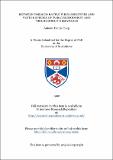Files in this item
Associations between tobacco rattle virus serotypes and vector species of 'paratrichodorus' and 'trichodorus' nematodes
Item metadata
| dc.contributor.advisor | Willmer, P.G. | |
| dc.contributor.author | Ploeg, Antoon Teunis | |
| dc.coverage.spatial | 222 p. | en_US |
| dc.date.accessioned | 2018-05-28T10:00:40Z | |
| dc.date.available | 2018-05-28T10:00:40Z | |
| dc.date.issued | 1992-07 | |
| dc.identifier.uri | https://hdl.handle.net/10023/13566 | |
| dc.description.abstract | Tobacco rattle virus (TRY) and trichodorid vector nematodes were found to be widespread in bulb growing areas in The Netherlands. Indications, obtained from pot bait tests, that associations between serotypes of tobacco rattle virus and Paratrichodorus and Trichodorus vector species occurred were confirmed in bait tests using individual trichodorid nematodes. Whereas different Paratrichodorus vector species each transmitted a serologically distinct TRV-isolate, different Trichodorus vector species transmitted serologically indistinguishable TRV-isolates. It remains to be studied whether a particular Trichodorus species is able to transmit all isolates serologically indistinguishable from the one with which it was naturally associated. A TRV-isolate transmitted by T. cylindricus from Scryne, Scotland and isolates transmitted by P. teres from Julianadorp, The Netherlands were considered anomalous TRV-isolates as they serologically resembled pea early-browning virus but had RNA-1 sequences typical of TRV. Virus-free P. pachydermus from Scotland and from The Netherlands acquired and subsequently transmitted TRV-isolates originally obtained from bait-plants infected by P. pachydermus from Scotland or The Netherlands. They failed to transmit a serologically similar isolate obtained from an infected potato tuber. Virus-free P. pachydermus did not acquire and transmit a pseudorecombinant TRV-isolate with the RNA-2 from a non-transmissible isolate, but efficiently transmitted a pseudorecombinant isolate in which the RNA-2 was derived from a efficiently transmitted isolate. This indicated that transmissibility is most likely determined by the virus coat-protein. Transgenic tobacco plants, expressing TRV coat-protein were resistant to mechanical inoculation but susceptible to nematode transmission of the virus. A possible low level of coat-protein expression in the roots could not fully explain this result as the nematodes also transmitted TRV directly to detached leaves of such transgenic plants. | en_US |
| dc.language.iso | en | en_US |
| dc.publisher | University of St Andrews | |
| dc.subject.lcc | SB608.T7P6 | |
| dc.subject.lcsh | Tobacco--Diseases and pests | |
| dc.title | Associations between tobacco rattle virus serotypes and vector species of 'paratrichodorus' and 'trichodorus' nematodes | en_US |
| dc.type | Thesis | en_US |
| dc.type.qualificationlevel | Doctoral | en_US |
| dc.type.qualificationname | PhD Doctor of Philosophy | en_US |
| dc.publisher.institution | The University of St Andrews | en_US |
This item appears in the following Collection(s)
Items in the St Andrews Research Repository are protected by copyright, with all rights reserved, unless otherwise indicated.

